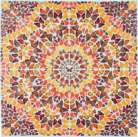
Pardon

Pardon
Signed Print
Damien Hirst
£8,000-£12,000
$16,000-$25,000 Value Indicator
$15,000-$22,000 Value Indicator
¥80,000-¥120,000 Value Indicator
€9,000-€14,000 Value Indicator
$90,000-$130,000 Value Indicator
¥1,590,000-¥2,390,000 Value Indicator
$11,000-$16,000 Value Indicator
There aren't enough data points on this work for a comprehensive result. Please speak to a specialist by making an enquiry.
92 x 92cm, Edition of 25, Screenprint
Auction Results

Track auction value trend
Meaning & Analysis
Pardon is a signed screen print in colours with diamond dust produced by renowned contemporary artist, Damien Hirst. The print, created by the artist in 2012, shows a mesmerising pattern of red, orange and brown butterflies. The autumnal colours used here by Hirst imbue the print with a sense of warmth, making it an inviting and visually appealing print. The intricate pattern is rendered on a square canvas and consists of concentric circles, with the butterflies emanating from a central red butterfly.
The butterfly is an iconic symbol that has become closely associated with Hirst and his artistic career. Hirst’s fascination with the insect stems, in part, from their ability to embody the fragility of life because, as the artist explains, butterflies retain an iridescent beauty even in death. Through the use of butterflies in his artworks, Hirst is able to explore questions of life and death, something important for the artist as he explains: “art’s about life and it can’t really be about anything else … there isn’t anything else.”
Hirst’s use of butterflies was inspired by a Victorian tea tray he found which was decorated with delicate patterns of butterfly wings. The print can be viewed alongside the Kaleidoscope series, an impressive body of work conceived by Hirst in 2001 which is characterised by magnificent circular patterns composed of butterfly wings.